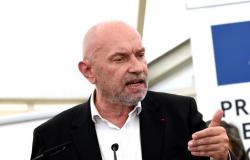
The meeting with renewable energy developers, organized by the prefecture on November 21 in Montpellier, allowed, among other things, to take stock of wind power and photovoltaics.
Hérault a bad student when it comes to the development of renewable energies? “We are very far from the objectives“, bluntly announces the prefect of Hérault, François-Xavier Lauch, in introduction to this meeting with renewable energy developers, this Thursday, November 21, at the Planet Océan Odysseum, in Montpellier.
If we refer to the framework letter on this subject, dated December 28, 2022, it is clear that “the energy production curves do not quiver. Only that of the production of renewable energies based on solar records a small increase “, he continues. As for the objectives to be achieved by 2030, the figures speak for themselves: production from photovoltaics must be multiplied by 5, from wind power, at sea and on land , by 2.
In other words, we will have to put the turbo on, but without doing anything and taking into account the questions of biodiversity, insufficiently addressed, according to him, in the files presented, in order to avoid disputes and unnecessary waste of time for their advancement.
Wind power in Hérault
Today, 337 MW are produced from 154 masts located in the department. The objective is to reach 540 MW by 2030, as recorded in the EnR (renewable energies) roadmap to implement PPE2, or multi-year energy programming. The 16 new masts authorized, but not yet built, and the 11 currently under investigation should provide an additional 108 MW, for a total of 445 MW, still far short of the expected 540 MW.
Five municipalities have defined five renewable energy acceleration zones (ZAER), bringing their number to 10 in Hérault, but representing only 12% of the wind ZAER areas defined in the region. Potential electricity production is estimated for these areas at 11 GWh per year, or less than 5% of wind production in Hérault.
“This is largely insufficient. We are really far from the mark. And, what's more, the vast majority of areas identified only concern existing parks. We also need to further study the possibilities of “repowering”(replacement of all or part of old energy infrastructures with new ones, Editor's note)”, underlines Marie-Hélène Bouissac, head of the Hérault departmental unit of the Regional Directorate for the Environment, Planning and Development. accommodation in Occitanie.
Photovoltaics in Hérault
Photovoltaic solar energy today represents 18% of renewable energy production in the department, or 480 Gwh and 501 MW in installed power. The objective by 2030 is to reach 1,120 Gwh. Here again, we are far from the mark. To reach them, “it will be necessary to double the panels on the ground, but this will still not be enough. It will therefore be necessary to develop the panels on the roofs as much as possible“, indicates Thierry Durand, deputy director of the Departmental Directorate of Territories and the Sea (DDTM). All installations combined, photovoltaics today occupies 264 ha.
With the evolution of regulations, the opportunities for project development are real, the latter can now be in sectors with medium “forest fire hazard” and even beyond, as well as in rainwater basins. or in flood-prone areas, subject to certain mandatory studies: conclusive forest fire risk study for the first case; hydraulic study and pollution management in the second; hydraulic study in the latter case and impact on the aquatic environment if it concerns floating photovoltaics.
On the other hand, certain sectors should be completely forgotten: those which are subject to classification (historical monuments, registered and classified sites, national nature reserves, biological reserves, heritage sites, UNESCO properties, etc.).
Which areas will be established tomorrow?
Rather than imposing, the State is now proposing that municipalities identify what it describes as acceleration zones for renewable energies (ZAEnR). “Municipalities have everything to gain, because they can thus guide project leaders and build a local energy strategy.“, underlines Pierre Giraud, energy transition project manager at DDTM.
To date, 102 municipalities have proposed 858 ZAEnR in Hérault. 95% of them opted for photovoltaic solar power and 5% for wind power. But as the regional objectives were not achieved, state services asked the municipalities to identify additional zones. 42 of them have already deliberated and around fifteen are in progress.
To achieve the objectives set for 2030, 250 ha must be found that can accommodate these renewable energy development projects. “These are few hectares to find. We just have to agree on the locations. In old quarries or recycling centers, you have to go for it. On the other hand, sites where biodiversity is very important should not even be thought about.“, concludes the prefect of Hérault. To the wise.





